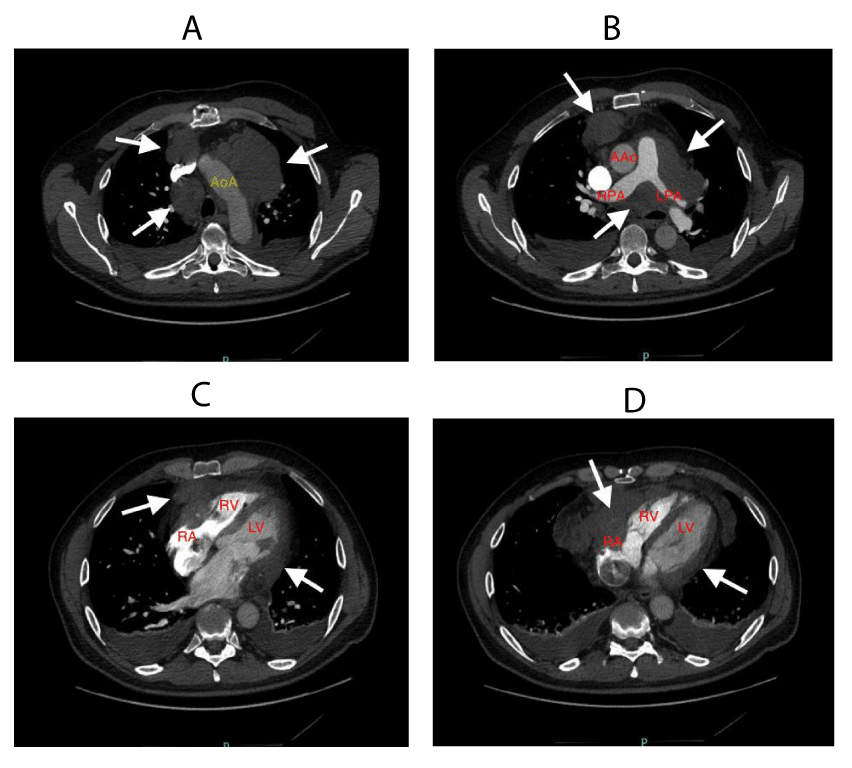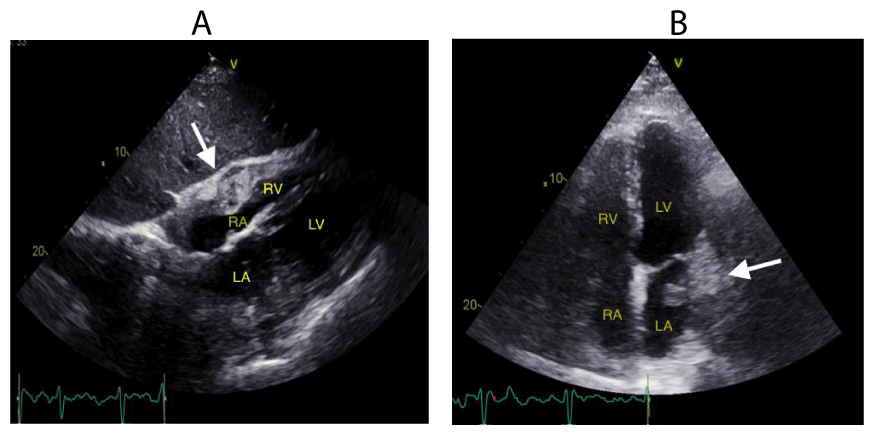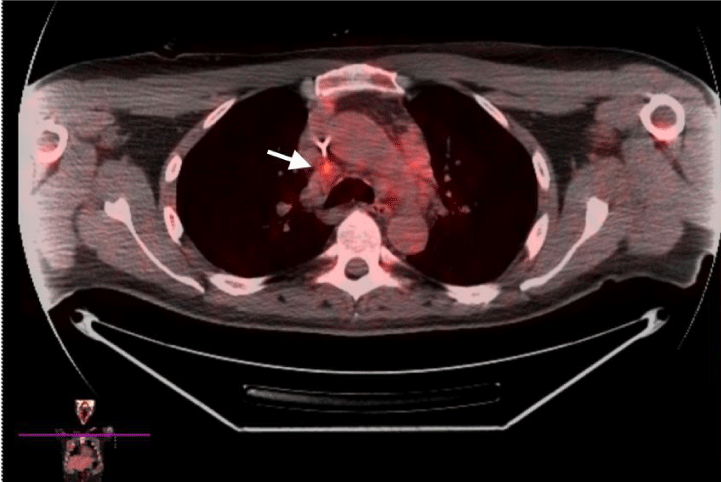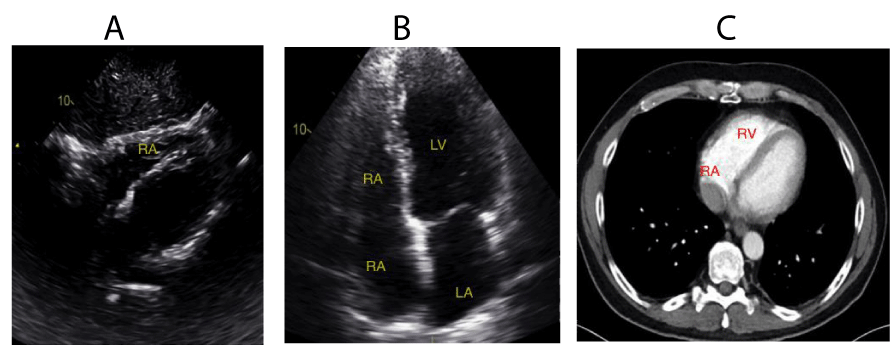Journal of Cardiovascular Medicine and Cardiology
Primary mediastinal large B-cell lymphoma with extensive cardiac involvement
Alma L Pulido1, Mike Cusnir2, Saberio Lo Presti3, Diego Lugo Baruqui1, Nicholas Suraci4* and Orlando Santana3
2Department of Hematology and Oncology, Mount Sinai Medical Center, Miami Beach, Florida, USA
3Columbia University, Division of Cardiology, Mount Sinai Heart Institute, Miami Beach, Florida, USA
4Department of Anesthesiology, Mount Sinai Medical Center, Miami Beach, Florida, USA
Cite this as
Pulido AL, Cusnir M, Presti SL, Baruqui DL, Suraci N, et al. (2019) Primary mediastinal large B-cell lymphoma with extensive cardiac involvement. J Cardiovasc Med Cardiol 6(3): 067-068. DOI: 10.17352/2455-2976.000094Data regarding the optimal therapeutic approach of patients with primary mediastinal B-cell lymphoma and cardia c involvement are limited. Reports suggest that multi-agent systemic chemotherapy, along with radiation therapy, may be effective in the treatment of these patients. However, a subgroup of patients do die suddenly due to myocardial rupture following the initiation of treatment. We report on the successful management of a patient with primary mediastinal large B-cell lymphoma with extensive cardiac involvement.
Introduction
A 61-year-old male with a past medical history of hypertension, dyslipidemia, presented to the emergency department complaining of dyspnea on exertion associated with palpitations for one week. A computerized tomography angiography of the chest obtained demonstrated extensive mediastinal lymphadenopathy with confluent soft tissue density narrowing and invading the central pulmonary arteries, coronary arteries, pericardium, right atrium, right ventricular free wall and left atrium (Figure 1). Transthoracic echocardiography showed a preserved systolic function with a heterogeneous mass embedded in the free wall of the right atrium extending into the free wall of the right ventricle, along with a 2.2cm×1.5cm mobile mass in the left atrium that was extending into the left ventricular free wall (Figure 2). A video assisted thoracoscopy, with biopsy, was performed which showed the mass to be a primary mediastinal B-cell lymphoma.
The patient was started on a dose-adjusted chemotherapy consisting of: etoposide, prednisone, vincristine, cyclophosphamide, doxorubicin and rituximab, completing 6 cycles. Six months later, transthoracic echocardiography, showed near complete resolution of the cardiac mass; while an 18F-fluorodeoxyglucose positron emission tomography with computed tomography scan showed activity in several mediastinal locations (Figure 3). Because of this, it was decided to continue treatment with adjuvant consolidative radiation therapy at the dose of 30 Gy to the mediastinum and 15-20 Gy to the area surrounding the heart. Nine months after initial diagnosis, repeat transthoracic echocardiography, computed tomographic angiography, and positron emission tomography with computed tomography showed complete remission of the disease (Figure 4). Two years after diagnosis, the patient is without evidence of active or recurrent disease.
Discussion
Primary mediastinal B-cell lymphoma accounts for 2%-4% of all non-Hodgkin’s lymphoma [1]. It typically affects young adults, occurring at a median age of 35 years, with a female to male ratio of 1.7-2 to 1. The most common presentation is an anterior mediastinal mass which may invade local structures. Involvement of the heart is usually a late manifestation of disseminated lymphoma and is commonly asymptomatic [1,2].
The standard treatment includes a combination of chemotherapy and mediastinal radiation. However, routine mediastinal radiation in those patients with lymphomatous cardiac involvement has been associated with an increased risk of free wall rupture and increased incidence of ischemic heart disease [2]. Transthoracic echocardiography is considered the first diagnostic modality, being useful in the evaluation of possible pericardial effusions, valvular involvement, and left ventricular function. Computerized tomography and magnetic resonance imaging may aid in evaluating morphology, location, and extension of disease [3]. While 18F-fluorodeoxyglucose positron emission tomography with computed tomography imaging is useful in the evaluation for the presence and extent of disease [4].
- Savage KJ, Monti S, Kutok JL, Cattoretti G, Neuberg D, et al. (2003) The molecular signature of mediastinal large B-cell lymphoma differs from that of other diffuse large B-cell lymphomas and shares features with classical Hodgkin’s lymphoma. Blood 102: 3871-3890. Link: http://bit.ly/32NQ9CP
- Dunleavy K, Wilson WH (2015) Primary mediastinal B-cell lymphoma and mediastinal gray zone lymphoma: do they require a unique therapeutic approach? Blood 125: 33-39. Link: http://bit.ly/2BG1Q2r
- Wang ZJ, Reddy GP, Gotway MB, Yeh BM, Hetts SW, et al. (2003) CT and MR imaging of pericardial disease. Radiographics 23: S167-S180. Link: http://bit.ly/368sQp6
- Nguyen JD, Carrasquillo JA, Little RF, Ryan QC, Wilson W, et al. (2003) Fluorodeoxyglucose positron emission tomography in the presence of cardiac metastases. Clin Nucl Med 28: 979-980. Link: http://bit.ly/347QgsP

Article Alerts
Subscribe to our articles alerts and stay tuned.
 This work is licensed under a Creative Commons Attribution 4.0 International License.
This work is licensed under a Creative Commons Attribution 4.0 International License.




 Save to Mendeley
Save to Mendeley
